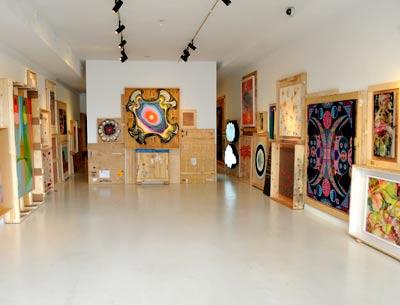Storage Wars at Firestone

Late summer on the South Fork can sometimes seem like a mostly deflated balloon: paunchy, flaccid, and spent. A sense of scraping bottom often takes hold, and any new endeavor, show, or exhibition is met with suspicion or derision, often borne of the same contagious exhaustion.
An initial suspicion that the “Storage Wars” show at East Hampton’s Eric Firestone Gallery was part and parcel of this overall trend — art in storage crates? Really? — turned out to be a symptom of a larger sense of ennui and not specific to the show itself. It’s actually . . . well . . . rather good.
Context is often, if not always, the thing in viewing art, and this exhibition, which puts art objects on display with their shipping crates, plays with the white cube gallery sterility in a pleasing way, adding warmth and a further dimension to the interaction with the works.
Firestone joined with the Hole, a Lower East Side gallery with a similar sensibility and aesthetic, to present works that, while part of each gallery’s collection, rarely see the light of day. The twist, as mentioned previously, is that the works are shown in or near their crates. The show features new works recently acquired, old inventory from gallery artists, and a few secondary market pieces.
With such a focus, the show has something to say about consumption and commodification of artworks. If art’s intrinsic value is visual, shouldn’t it actually be seen? And if not, what other forces are at work?
That’s a rhetorical question, but one that bears repeating time and again. The bloated wallets and offshore bank accounts of the 1 percent have contributed to the insatiable appetite of that group’s collectors, who buy art the way others might gobble down salted peanuts. The purchase could be about the art or just as easily about having one of the next big thing’s works or beating out a competing bidder in an auction room. What if the next big thing isn’t to your taste? What happens when it gets to one of your houses, if it makes it that far?
This isn’t just a syndrome for individuals, either. Many museums, which stake their reputation on their collections, often show mere microcosms of what they have in storage, counting on temporary themed exhibitions and loans to other institutions to put their works on view.
The real question becomes “Why are these works not receiving attention? Is there anything wrong, weak, or failed about them?” In the case of this show, for the most part the answer is no. Not everything will be to one’s liking and there is a lot of that abstraction that is coming under critical scrutiny these days for being too similar and, yes, market-driven.
But I like the show. It’s exuberant and bright and doesn’t tax a late-summer brain too much. The sum is definitely stronger than the parts and the raw wood cases make a grittier and unusual foil to the often highly finished pieces within them. Each piece has a freshness about it that is derived very much from the context.
Two of my favorite pieces, recent small works by Ross Bleckner, seem to have wandered in from another planet, but are reminders as to why he is such a powerful artist. Matthew Stone’s photograph-print veneers on glass are also game, offering quite a bit to unpack in terms of medium and support as we begin to decode them.
Sanford Biggers’s happy and not-so-happy clouds, backlit in vinyl and plexiglass or drawn and spray-painted on fabric, are a great dose of whimsy for the weary viewer. It’s hard not to smile when looking at them. Evan Robart’s ball-and-chain-link fence sculpture was another piece that had a simple premise that still managed to trigger relational thinking and an appreciation for the tension between balance and irrationality.
Many of the surprises in the show came not from the unfamiliar works and artists, but from known works decontextualized in this setting. A good exhibition will offer that change up, and this one succeeds in making an end-of-season group show something to think about in the quieter months ahead.
The exhibition will be on view through Sept. 7.
